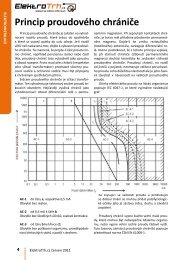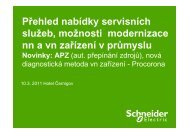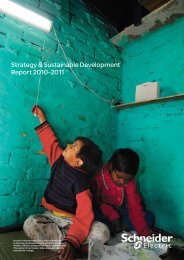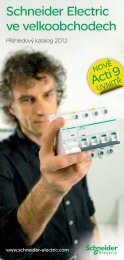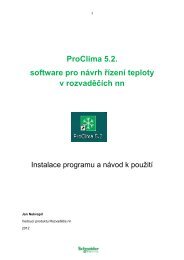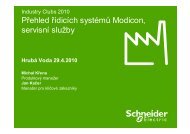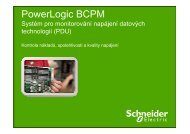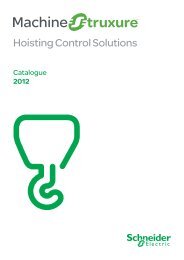2010Annual Report - Schneider Electric CZ, s.r.o.
2010Annual Report - Schneider Electric CZ, s.r.o.
2010Annual Report - Schneider Electric CZ, s.r.o.
Create successful ePaper yourself
Turn your PDF publications into a flip-book with our unique Google optimized e-Paper software.
Management of waste, emissions and industrial<br />
pollution<br />
Waste<br />
Because waste is a major source of pollution but also a potential<br />
source of raw materials, waste management is a priority in<br />
environmental protection.<br />
Most of the Group’s waste is solid waste. Continuous improvement<br />
plans have been deployed to manage this waste. This approach<br />
fi ts in fully with the ISO 14001 approach that all <strong>Schneider</strong> <strong>Electric</strong><br />
production and logistics sites worldwide are required to follow.<br />
Because classifi cation systems vary widely from country to country,<br />
the Group does not consolidate global data by category (hazardous<br />
and non-hazardous). Data is processed to ensure local traceability.<br />
In France, for example, hazardous industrial waste accounts for<br />
around 14% of total waste. All waste is channeled to the appropriate<br />
treatment facility.<br />
<strong>Schneider</strong> <strong>Electric</strong> notes the quantities of waste produced and<br />
recycled on a six monthly basis and monitors this production per<br />
capita, on a like-for-like basis in order to evaluate its performance<br />
from one year to the next.<br />
The overall eco-production approach helped reduce our production<br />
of waste by 4.8% per capita in 2010 compared with 2009 on a<br />
comparable basis and to increase the proportion of waste recycled<br />
from 80% in 2009 to 84% in 2010 on a comparable basis. The<br />
Group has not deployed any specifi c Group action plan in this area<br />
in 2010.<br />
Conditions of use and soil contamination<br />
Virtually all <strong>Schneider</strong> <strong>Electric</strong> sites are located in urban or industrial<br />
areas and do not affect any notable biotopes. None of the Group’s<br />
businesses involve extraction or land farming.<br />
No substances are purposely released into the soil in the course<br />
of site operation. Workshop fl ooring is specially treated to prevent<br />
any leakage. Hazardous substances are systematically stored<br />
and handled in areas equipped with retention tanks. Retention<br />
systems are designed to compensate in the event of malfunctions<br />
or emergencies, such as fi res.<br />
In 2010 <strong>Schneider</strong> <strong>Electric</strong> conducted its annual review of pollution<br />
risks at all manufacturing sites as part of ISO 14001 tracking. No<br />
major incident was reported in 2010.<br />
SUSTAINABLE DEVELOPMENT<br />
SCHNEIDER ELECTRIC’S COMMITMENT TO ENVIRONMENTAL PERFORMANCE<br />
Discharge into the water and air<br />
Because <strong>Schneider</strong> <strong>Electric</strong> is mainly an assembler, its discharge into<br />
the air and water is very limited. Mechanical component production<br />
workshops are carefully monitored, in keeping with their ISO 14001<br />
certifi cation. Their releases are tracked locally as required by current<br />
legislation. No major spills or discharges were reported in 2010.<br />
Noise and odors<br />
All <strong>Schneider</strong> <strong>Electric</strong> sites comply with noise and odor limits.<br />
Environmental risk management and prevention<br />
The ISO 14001 environmental management system covers<br />
management of environmental risks. No <strong>Schneider</strong> <strong>Electric</strong> sites are<br />
Seveso classifi ed. Aside from the voluntary prevention measures<br />
discussed above for sites with a soil contamination history, no<br />
amounts have been paid out in connection with a legal ruling.<br />
All of the Group’s industrial sites, which are ISO 14001 certifi ed, have<br />
procedures in place to prevent emergencies and respond effectively<br />
if necessary. Preventive and corrective action plans are based on an<br />
analysis of non-standard situations and their potential impact. This<br />
analysis draws in part on hazard reviews for classifi ed installations.<br />
In France, for example, certain sites that handle large amounts of<br />
chemical compounds, such as Le Vaudreuil, MGA and 38TEC,<br />
are equipped with balloon-type containment systems to avoid any<br />
pollution through the water network. Others, located next to a river,<br />
have fl oating beams.<br />
Drills are held regularly throughout the year to ensure that supporting<br />
procedures are ready and effective.<br />
A national organisation has been set up to track sensitive sites.<br />
Their managers systematically receive training in environmental<br />
crisis management. Directives, procedures and national guidelines<br />
concerning environmental crisis management, historical and<br />
current operations management, pollution risk prevention and other<br />
topics are available on the intranet. Internal audits verify that these<br />
procedures are applied correctly.<br />
2010 REGISTRATION DOCUMENT SCHNEIDER ELECTRIC 71<br />
2




